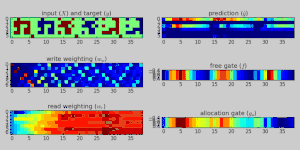Alex Graves (computer scientist)
Alex Graves is a research scientist at DeepMind. He did a BSc in Theoretical Physics at Edinburgh and obtained a PhD in AI under Jürgen Schmidhuber at IDSIA.[1] He was also a postdoc at TU Munich and under Geoffrey Hinton[2] at the University of Toronto.
At IDSIA, he trained long short-term memory neural networks by a novel method called connectionist temporal classification (CTC).[3] This method outperformed traditional speech recognition models in certain applications.[4] In 2009, his CTC-trained LSTM was the first recurrent neural network to win pattern recognition contests, winning several competitions in connected handwriting recognition.[5][6] This method has become very popular. Google uses CTC-trained LSTM for speech recognition on the smartphone.[7][8]
Graves is also the creator of neural Turing machines[9] and the closely related differentiable neural computer.[10][11]
References
- "Alex Graves - Research Scientist @ Google DeepMind". Retrieved May 17, 2016.
- "Marginally Interesting: What is going on with DeepMind and Google?". Blog.mikiobraun.de. Retrieved May 17, 2016.
- Alex Graves, Santiago Fernandez, Faustino Gomez, and Jürgen Schmidhuber (2006). Connectionist temporal classification: Labelling unsegmented sequence data with recurrent neural nets. Proceedings of ICML’06, pp. 369–376.
- Santiago Fernandez, Alex Graves, and Jürgen Schmidhuber (2007). An application of recurrent neural networks to discriminative keyword spotting. Proceedings of ICANN (2), pp. 220–229.
- Graves, Alex; and Schmidhuber, Jürgen; Offline Handwriting Recognition with Multidimensional Recurrent Neural Networks, in Bengio, Yoshua; Schuurmans, Dale; Lafferty, John; Williams, Chris K. I.; and Culotta, Aron (eds.), Advances in Neural Information Processing Systems 22 (NIPS'22), December 7th–10th, 2009, Vancouver, BC, Neural Information Processing Systems (NIPS) Foundation, 2009, pp. 545–552
- A. Graves, M. Liwicki, S. Fernandez, R. Bertolami, H. Bunke, J. Schmidhuber. A Novel Connectionist System for Improved Unconstrained Handwriting Recognition. IEEE Transactions on Pattern Analysis and Machine Intelligence, vol. 31, no. 5, 2009.
- Google Research Blog. The neural networks behind Google Voice transcription. August 11, 2015. By Françoise Beaufays http://googleresearch.blogspot.co.at/2015/08/the-neural-networks-behind-google-voice.html
- Google Research Blog. Google voice search: faster and more accurate. September 24, 2015. By Haşim Sak, Andrew Senior, Kanishka Rao, Françoise Beaufays and Johan Schalkwyk – Google Speech Team http://googleresearch.blogspot.co.uk/2015/09/google-voice-search-faster-and-more.html
- "Google's Secretive DeepMind Startup Unveils a "Neural Turing Machine"". Retrieved May 17, 2016.
- Graves, Alex; Wayne, Greg; Reynolds, Malcolm; Harley, Tim; Danihelka, Ivo; Grabska-Barwińska, Agnieszka; Colmenarejo, Sergio Gómez; Grefenstette, Edward; Ramalho, Tiago (2016-10-12). "Hybrid computing using a neural network with dynamic external memory". Nature. 538 (7626): 471–476. Bibcode:2016Natur.538..471G. doi:10.1038/nature20101. ISSN 1476-4687. PMID 27732574. S2CID 205251479.
- "Differentiable neural computers | DeepMind". DeepMind. Retrieved 2016-10-19.
